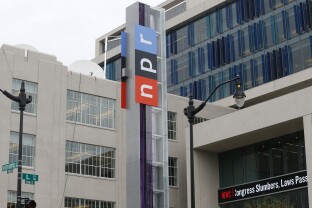The Trump administration’s war on PBS and NPR could have an outsized impact on rural communities’ access to basic information about local events, from severe storms to high school football games, lawmakers, public media advocates and researchers say.
President Donald Trump signed an executive order late Thursday ordering the Corporation for Public Broadcasting to stop funding PBS and NPR, claiming the broadcasters have “fueled partisanship and left-wing propaganda with taxpayer dollars” in their news coverage.
“Unlike in 1967, when the CPB was established, today the media landscape is filled with abundant, diverse, and innovative news options,” Trump wrote.
But rural Americans’ options for places to get reliable information about their communities are anything but “abundant” and “diverse,” advocates, researchers and lawmakers said Friday. In the last two decades, the U.S. lost around a third of its local newspapers, leaving nearly 55 million people with “limited or no access to local news,” Northwestern University’s Medill Local News Initiative found.
“In some counties, NPR is the only source of local news, and so those threats to NPR are a threat to information access in many of these communities,” Zach Metzger, director of the Medill State of Local News Project, told NOTUS. “This is extremely important in instances of natural disasters and instances of emergencies, where in rural communities, there might be very limited broadband access, there might be limited cellular data access.”
Because rural stations have smaller audiences, they receive fewer donations and rely more on federal funds than stations based in major cities. After news reports last month indicated Trump planned to ask Congress to pull $1.1 billion in CPB funding, one Alaska station requested its listeners to ask the state’s congressional delegation to vote against it.
“CPB funding is essential to our mission, supplying broadcasting and emergency alert system equipment, plus salaries and gear for the local journalists in our 3-person newsroom. As a rural station, KHNS receives proportionately more funding from CPB than stations in more populous regions,“ the station wrote earlier this week. “KHNS cannot provide the same level of service, emergency preparedness and community responsiveness with 36% less funding.”
Anticipating attacks from the administration, PBS commissioned a poll in February, which showed 65% of Trump voters thought public TV was adequately funded or underfunded, and that 72% valued PBS’ educational and children’s programming.
But PBS’ favorability among Trump’s own base hasn’t stopped the right from going after public broadcasting — CPB’s funding was also explicitly laid out as a target in Project 2025. The White House also tried to fire three of the corporation’s five board members, which a judge put on hold for now earlier this week.
With cut or reduced federal support, rural TV stations are at even more risk than radio stations. TV stations are more expensive to operate than radio, so more federal public broadcasting funds go to PBS than NPR.
Local TV broadcasters rely on funding from the CPB and their partnerships with PBS. The television network partners with over 330 stations, and it estimates 60% of its viewership lives in rural areas.
“Some of the most significant costs for local member stations are infrastructure and production of local content and these would likely be most impacted, meaning less local content and jeopardizing stations’ ability to reach their viewers with that content, as well as critical information during emergencies,” PBS wrote on Friday.
The nonprofit organization America’s Public Television Stations said Trump’s order, if it went into effect, could shutter rural TV stations.
“These restrictions would be particularly damaging to local stations serving smaller, more rural communities that rely on federal funding for a higher percentage of their budget. This order would make it impossible for many stations to secure programming and services needed by their communities,” said Kate Riley, the president of America’s Public Television Stations, in a Friday statement.
PBS, NPR and CPB have also all signaled that they’re prepared to fight to keep these funds — PBS President Paula Kerger called the order “blatantly unlawful” and said the organization was “exploring all options to allow PBS to continue to serve our member stations and all Americans.”
Patricia Harrison, CPB’s president, maintained in a statement Friday that the organization was not under the president’s control, since Congress intended it to operate as “a private nonprofit corporation wholly independent of the federal government.”
And NPR promised to “challenge this Executive Order using all means available” in a statement.
“This action jeopardizes the national airing of beloved programming and essential news such as NPR’s iconic hourly Newscast, Morning Edition, and Tiny Desk Radio. It seeks to deprive tens of millions of Americans of their regular, trusted sources of information, and cut off resources to award-winning reporting and cultural programming,” NPR’s news release said.
Democratic lawmakers decried Trump’s late-night order as an attack against free speech.
“He’s going after Sesame Street, emergency alert systems, rural stations and educational shows for kids,” Democratic Rep. Dan Goldman posted Friday. “This is another attack on free speech and accountability.”
—
Emily Kennard is a NOTUS reporter and an Allbritton Journalism Institute fellow.
Sign in
Log into your free account with your email. Don’t have one?
Check your email for a one-time code.
We sent a 4-digit code to . Enter the pin to confirm your account.
New code will be available in 1:00
Let’s try this again.
We encountered an error with the passcode sent to . Please reenter your email.


